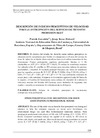Please use this identifier to cite or link to this item:
https://accedacris.ulpgc.es/jspui/handle/10553/10028
| DC Field | Value | Language |
|---|---|---|
| dc.contributor.author | Zawadzki, Patrick | en_US |
| dc.contributor.author | Roca i Balasch, Josep | en_US |
| dc.date.accessioned | 2013-04-26T05:00:29Z | |
| dc.date.accessioned | 2018-03-15T14:24:46Z | - |
| dc.date.available | 2013-04-26T05:00:29Z | |
| dc.date.available | 2018-03-15T14:24:46Z | - |
| dc.date.issued | 2007 | en_US |
| dc.identifier.issn | 1886-8576 | en_US |
| dc.identifier.uri | https://accedacris.ulpgc.es/handle/10553/10028 | - |
| dc.description.abstract | El objetivo del estudio fue describir cuatro indicios perceptivos en situación real de competición para facilitar la anticipación en el resto del servicio de tenis. Se utilizó de un diseño observacional con base en el análisis cinemático de dos dimensiones. Fueron participantes jugadores profesionales diestros (n = 18) clasificados en ATP (M = 112.84, DT = 86.02). El análisis de correlación canónica fue utilizado sobre 42 variables en 293 servicios para encontrar indicios de apertura, profundidad y velocidad. El resultado principal demostró una fuerza de correlación para los segundos servicios de Rc = 0.97 (Wilks = 0.0056, Chisq = 303.45, pChisq < 0.001, F = 4.67, pF < 0.001, df1 = 117, df2 = 117.74). Los coeficientes canónicos de mayor peso y más anteriores al impacto en la ecuación sugieren el codo del brazo de la raqueta y el hombro del lanzamiento como indicios de velocidad. Se evidencia la relevancia temática del Estudio del Contrario como facilitador de respuestas más rápidas y ajustadas en situaciones de enfrentamiento en el deporte. | en_US |
| dc.description.abstract | The aim of this study was to describe four perceptual cues during real situation to help the anticipate response on tennis serve devolutions. An observational design was used thru bi-dimensional kinematics analysis. Were participants professional male players (n=18) with ATP ranking (M = 112.84, DT = 86.02). Canonical correlation analysis was applied in 42 variates by 293 serves to define wide, depth, and speed cues. Main result showed strong correlation on second serves Rc = 0.97 (Wilks = 0.0056, Chisq = 303.45, pChisq < 0.001, F = 4.67, pF < 0.001, df1 = 117, df2 = 117.74). Inside equation strongest canonical coefficients earlier from impact suggest the racket elbow and toss shoulder as speed perceptual cues. The Opponent Study importance as facilitator of faster and better adjusted responses in sport opposition situations was marked. | en_US |
| dc.format | application/pdf | es |
| dc.language | spa | en_US |
| dc.relation.ispartof | Revista Iberoamericana de Psicologia del Ejercicio y el Deporte | en_US |
| dc.source | Revista Iberoamericana de Psicología del Ejercicio y el Deporte. Sevilla : Wanceulen, 2006- .-- ISSN 1886-8576. año 2012, vol. 7, n. 2 | en_US |
| dc.subject | 61 Psicología | en_US |
| dc.subject.other | Indicios de velocidad | en_US |
| dc.subject.other | Percepción de movimiento | en_US |
| dc.subject.other | Anticipación | en_US |
| dc.subject.other | Tenis profesional | en_US |
| dc.title | Descripción de indicios perceptivos de velocidad para la anticipación del servicio de tenistas profesionales. | en_US |
| dc.type | info:eu-repo/semantics/article | en_US |
| dc.type | Article | en_US |
| dc.compliance.driver | 1 | es |
| dc.identifier.absysnet | 537108 | - |
| dc.investigacion | Artes y Humanidades | en_US |
| dc.rights.accessrights | info:eu-repo/semantics/openAccess | es |
| dc.type2 | Artículo | en_US |
| dc.identifier.ulpgc | Sí | es |
| dc.description.sellofecyt | Sello FECYT | |
| dc.description.esci | ESCI | |
| dc.description.erihplus | ERIH PLUS | |
| item.fulltext | Con texto completo | - |
| item.grantfulltext | open | - |
| Appears in Collections: | Rev. Iberoam. psicol. ejerc. deporte. 2012. v.7, n.2 Artículos | |
Items in accedaCRIS are protected by copyright, with all rights reserved, unless otherwise indicated.
